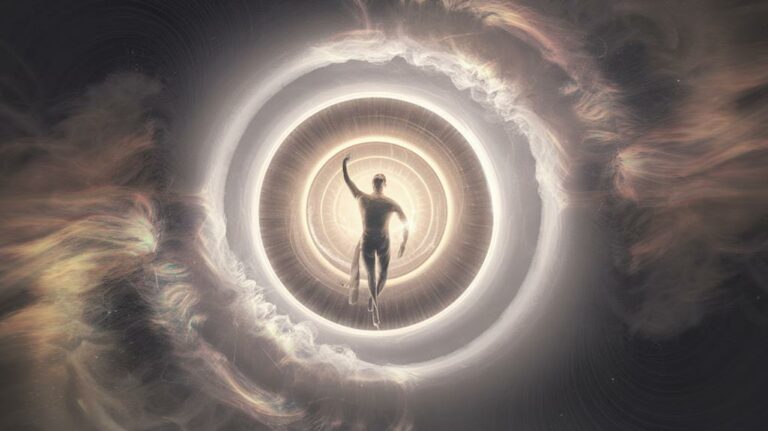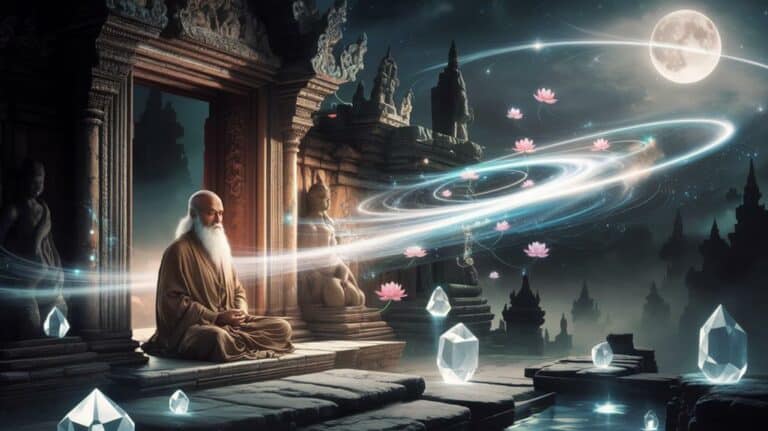Quantum Mysticism
When you explore the domain of quantum mysticism, you’re venturing into a fascinating intersection where the principles of quantum mechanics meet the spheres of spirituality. Concepts like quantum entanglement, where particles remain connected across vast distances, and the observer effect, which suggests that consciousness can influence physical states, challenge traditional notions of a fixed reality. This intersection raises intriguing questions about the interconnectedness of consciousness and the universe, prompting you to contemplate whether science and spirituality can coexist in a way that redefines our understanding of existence. As you navigate this complex terrain, you’ll encounter both compelling arguments and fierce criticisms that will leave you pondering the very nature of reality.
Quantum Entanglement Explained
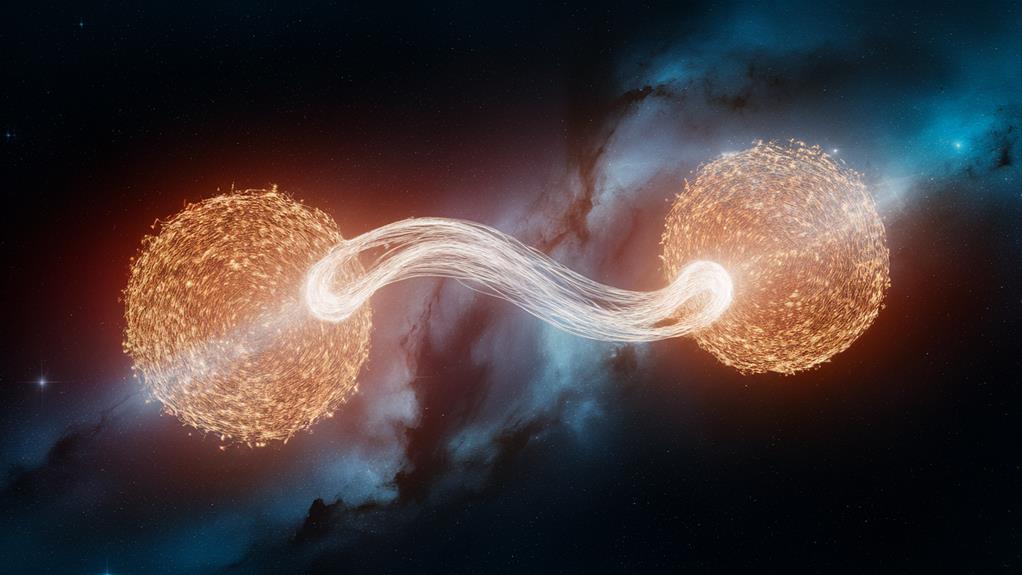
When delving into the sphere of quantum mysticism, one of the key concepts often misinterpreted and mystified is quantum entanglement. This phenomenon, often described by Albert Einstein as “spooky action at a distance,” involves the interconnectedness of two or more particles in such a way that the state of one particle is instantly affected by the state of the other, regardless of the distance between them.
Imagine two particles, once bonded, now separated to opposite ends of the universe. If something happens to one particle, it instantly affects the other, even if they’re light-years apart. This challenges our classical understanding of space and time, suggesting that there are connections that transcend our conventional notions of distance and causality.
In the sphere of quantum mysticism, this concept is often stretched to imply a deeper, spiritual interconnectedness of all things. While scientists view entanglement as a fascinating aspect of quantum mechanics, mystics see it as evidence of a more profound, non-material reality where consciousness and the universe are intricately linked.
As you ponder entanglement, you may find yourself questioning the very fabric of reality and the role of consciousness within it, inviting a contemplation that blurs the lines between the physical and the spiritual.
Superposition and Reality
Moving from the intriguing concept of quantum entanglement, you’re now faced with another fundamental aspect of quantum mechanics that quantum mystics often misinterpret: superposition. In the quantum domain, superposition allows a particle to exist in multiple states simultaneously, a concept that challenges our classical understanding of reality.
This idea resonates deeply with those inclined towards mysticism, who see it as a metaphor for the multidimensional nature of consciousness and the human experience.
As you explore superposition, you begin to question the fixed nature of reality. If a particle can be in multiple states at once, what does this imply about our own existence? Quantum mystics often argue that this principle reflects the fluid, ever-changing nature of consciousness, suggesting that our perceptions and realities aren’t rigid but rather dynamic and interconnected.
However, it’s vital to distinguish between the scientific phenomenon and its metaphysical interpretations. While superposition is a well-documented aspect of quantum mechanics, its extension into spiritual or mystical domains remains speculative.
Nonetheless, this concept invites you to ponder the boundaries of reality and the intricate web of existence, encouraging a profound reflection on the interplay between the physical and the subjective. In this domain, the lines between science and spirituality blur, offering a glimpse into a universe where the observer and the observed are indistinguishable.
Observer Effect’s Implications

The observer effect in quantum mechanics, where the act of measurement influences the state of a particle, has significant implications that often get misinterpreted by quantum mystics. As you explore this concept, you may find yourself pondering the nature of reality and the role of observation.
In quantum mechanics, particles exist in a state of superposition until observed, at which point they collapse into a definite state. This phenomenon has led some to suggest that consciousness plays a central role in shaping reality, a notion that resonates deeply with those seeking a spiritual or mystical connection.
However, this interpretation is often a stretch from the scientific facts. Quantum physicists like Niels Bohr and Albert Einstein were cautious about attributing mystical significance to these observations. Bohr, for instance, rejected the idea that quantum theory requires a conscious observer, emphasizing instead the mechanical aspects of measurement.
As you reflect on the observer effect, consider how it challenges your understanding of the interplay between the observer and the observed. It invites you to question whether reality is inherently dependent on our perception or if it exists independently, awaiting our discovery.
This inquiry isn’t just about the physics itself but about the profound implications it holds for our understanding of existence and our place within it. In this contemplation, you may find that the boundaries between science and spirituality begin to blur, prompting a deeper exploration of what it means to be conscious and present in the world.
Quantum Consciousness Theories
Quantum consciousness theories emerge from the intersecting domains of physics and philosophy, often blurring the lines between scientific inquiry and metaphysical speculation. As you investigate these theories, you find yourself at the crossroads of the tangible and the intangible, where the principles of quantum mechanics are invoked to explain the enigmatic nature of consciousness.
One of the most compelling theories is the Orchestrated Objective Reduction (Orch-OR) theory, co-developed by Roger Penrose and Stuart Hameroff. This theory posits that consciousness arises from the collapse of quantum wave functions in microtubules within neurons, triggered by gravitational instabilities in space-time. This idea suggests that each collapse of the quantum wave function generates a moment of conscious experience, bridging the gap between the quantum world and our subjective reality.
Other approaches, such as those by Herbert Fröhlich and Hiroomi Umezawa, propose that quantum fields and Bose-Einstein condensates play significant roles in brain processes, including memory and cognition. These theories challenge the traditional view of consciousness as solely a product of classical physics, instead suggesting that quantum mechanics is integral to understanding our conscious experience.
As you explore these theories, you’re invited to contemplate the profound implications of quantum consciousness: the possibility that our minds aren’t just products of physical processes, but are intertwined with the fundamental fabric of the universe itself. This reflection opens up new avenues for understanding the human experience, inviting a deep and awe-inspired exploration of what it means to be conscious.
Quantum Physics Meets Spirituality
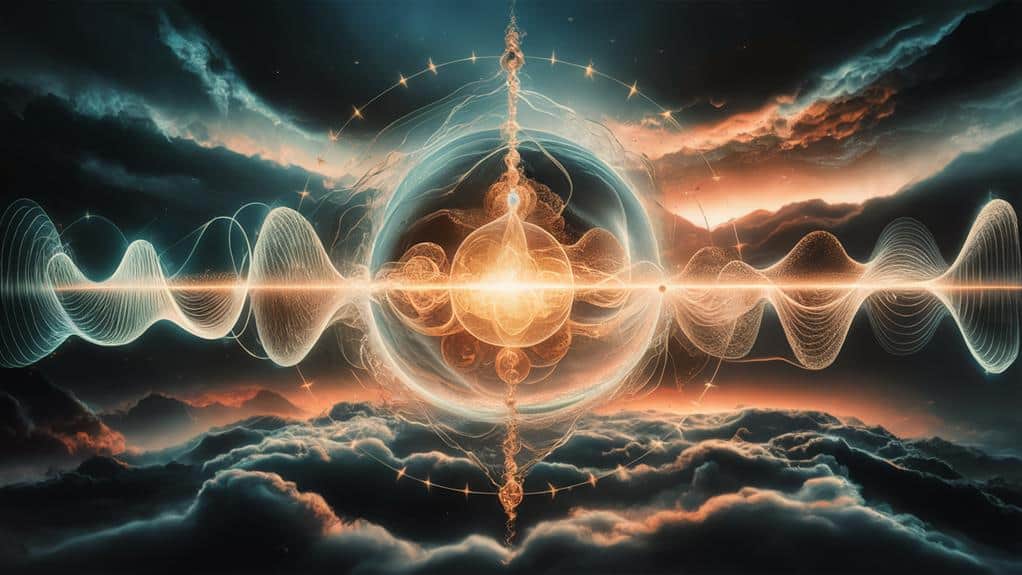
As you explore the intersection of quantum physics and spirituality, you find yourself in a domain where scientific theories and metaphysical beliefs intertwine. This convergence challenges the traditional dichotomy between the material and the spiritual, suggesting that the universe is an interconnected, holistic entity where consciousness plays a central role.
Quantum phenomena such as entanglement and the observer effect resonate deeply with spiritual concepts of unity and the power of consciousness. Entanglement, where particles remain connected across vast distances, mirrors the spiritual idea of oneness, highlighting that everything in the universe is fundamentally connected.
The observer effect, which shows that observation can alter the state of particles, aligns with spiritual teachings that our thoughts and intentions shape our reality.
These parallels invite you to contemplate the nature of reality and your place within it. If consciousness is primary, as suggested by quantum theories and Eastern philosophies, then the universe begins to look more like a great thought than a great machine.
This perspective transforms your understanding of the world, encouraging a deeper sense of empathy, compassion, and responsibility for the well-being of all living beings. As you investigate this intersection, you may find that science and spirituality aren’t opposing forces, but complementary paths to understanding the profound mysteries of existence.
Critics and Skeptics
Critics of quantum mysticism are numerous and vocal, arguing that this movement misappropriates and misinterprets the principles of quantum mechanics to support metaphysical and spiritual claims.
These skeptics point out that quantum mysticism often relies on a superficial understanding of quantum physics, using buzzwords like “energy field” and “wave-particle duality” to justify irrational beliefs without any mathematical or empirical backing.
You may notice that critics, such as physicists like Brian Cox and John Gribbin, challenge proponents of quantum mysticism to provide scientific evidence for their claims. For instance, Brian Cox has suggested that proponents like Deepak Chopra should first solve the Schrödinger equation for a spherically symmetrical potential before discussing quantum healing, highlighting the gap between genuine scientific inquiry and pseudoscientific interpretations.
The skepticism stems from the observation that quantum mysticism blurs the lines between science and spirituality, leading to a form of “quantum woo” that exploits the public’s fascination with quantum physics to validate metaphysical ideas.
This critique isn’t just about the misuse of scientific terminology but also about the integrity of scientific inquiry and the importance of distinguishing between evidence-based knowledge and mystical speculation.
As you explore these criticisms, you’re invited to reflect on the boundaries between science and spirituality, and the dangers of conflating these distinct domains.
Experimental Evidence

When examining the claims of quantum mysticism, it becomes clear that there’s a stark lack of experimental evidence to support its metaphysical and spiritual assertions.
Despite the elaborate theories and philosophical musings, quantum mysticism remains grounded in pseudoscience rather than empirical proof. In contrast, the principles of quantum mechanics themselves are backed by a wealth of experimental evidence.
Experiments such as those conducted by Alain Aspect, John Clauser, and others have conclusively demonstrated the reality of quantum entanglement and non-locality.
These experiments, based on Bell’s theorem, have been replicated numerous times and have consistently shown that quantum mechanics violates the limits imposed by local hidden variable theories.
The precision and reliability of these experiments stand in sharp contrast to the vague and untestable claims of quantum mysticism.
Quantum mechanics, as a scientific theory, is rigorously tested and validated through continuous experimentation, ensuring that its predictions are accurate and its principles are well-understood.
This rigorous scientific approach highlights the clear distinction between the empirical foundations of quantum physics and the unfounded speculations of quantum mysticism.
Philosophical Perspectives
The philosophical landscape of quantum mechanics is a complex and debated domain, where physicists and philosophers grapple with the implications of quantum phenomena on our understanding of reality.
As you explore the domain of quantum mysticism, you encounter a blend of scientific theories and mystical worldviews that challenge traditional notions of consciousness, spirituality, and the interconnectedness of all things.
Quantum mysticism suggests that consciousness plays a pivotal role in shaping the physical world, particularly in the collapse of the wave function, where quantum particles shift from superposition to a definite state. This idea resonates with Eastern philosophical concepts, such as non-duality and the interconnectedness of all beings.
Proponents argue that this perspective dissolves the boundaries between the mind and body, proposing a third possibility beyond dualism and monism: that the mind and body are interconnected but not identical.
This philosophical framework also questions our sense of separateness and free will. If consciousness influences the physical world, it implies that our thoughts and intentions have real impact, challenging the notion that free will is an illusion.
The indeterminacy principle of quantum mechanics is seen as supporting the idea that we’ve more free will than traditionally thought. However, critics argue that these interpretations misappropriate and oversimplify both scientific and Eastern philosophical concepts, rendering quantum mysticism more a matter of personal belief than a scientifically grounded theory.
Future of Quantum Mysticism
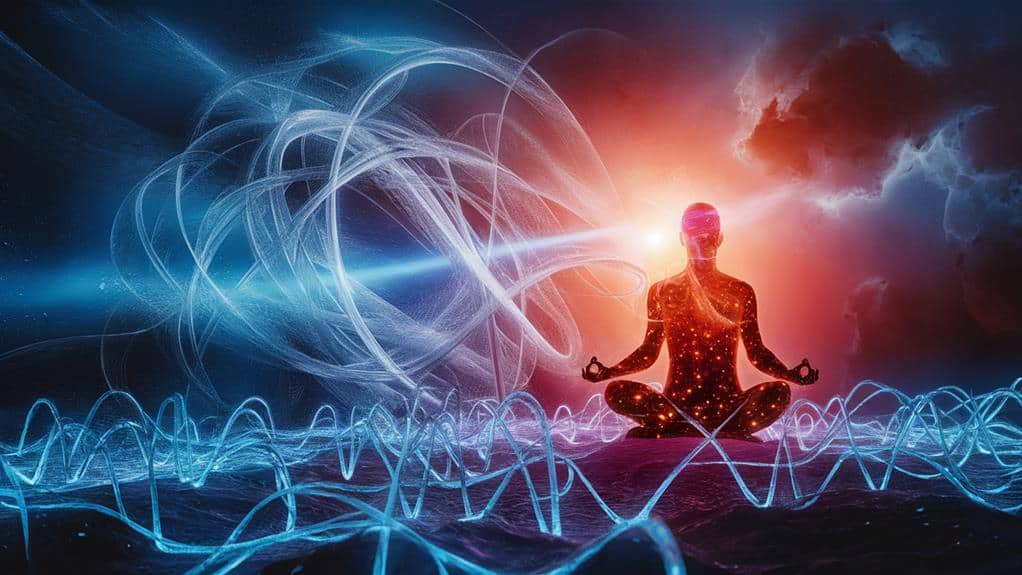
As you look to the future of quantum mysticism, it’s clear that this blend of scientific and mystical concepts will continue to attract both adherents and skeptics. The intersection of quantum mechanics and consciousness, once a topic of intense debate among pioneers like Einstein, Bohr, and Schrödinger, now evolves into more nuanced and ambitious domains.
Researchers like Stuart Hameroff and Mani Bhaumik are exploring the idea that subtle quantum effects could be essential in the emergence of conscious mind, potentially linking human consciousness to a universal, proto-conscious mind at the fundamental level of the universe.
This speculative territory, often labeled as “quantum mysticism,” may seem fringe, but it holds the promise of revolutionizing our understanding of reality and our place within it. As quantum technology advances, bringing breakthroughs in computing, encryption, and medical diagnostics, the philosophical underpinnings of these innovations could lead to profound shifts in how we perceive the world and ourselves.
The future of quantum mysticism invites you to ponder the possibility that consciousness isn’t just a byproduct of brain activity but an intrinsic aspect of the universe, intertwined with its very fabric.
This perspective, though still on the cusp of mainstream acceptance, beckons you to explore the deepest mysteries of existence, where science and mysticism converge in a quest for ultimate understanding.
Conclusion
As you explore the domain of quantum mysticism, you are invited to ponder the profound interconnectedness of consciousness and reality. Quantum entanglement and the observer effect hint at a universe where consciousness influences physical states, blurring the lines between the self and the cosmos. While skeptics argue against spiritual interpretations, the dialogue itself urges a deeper reflection on existence and our collective responsibility. Embrace this journey, and you may find that the mysteries of quantum physics resonate deeply with the essence of human experience.







